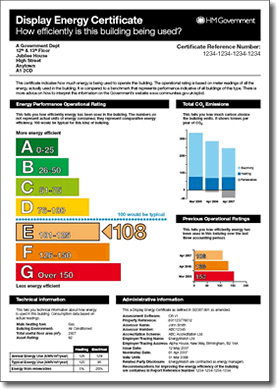Do you need a Display Energy Certificate ?
You will have heard about Energy Performance Certificates (EPCs) and the full roll out that finished on the 1st October. Anyone involved in domestic or non domestic property will come across them in some capacity. However, in amongst all the legislation in the regulations there is another requirement that may take some by surprise.
 From 1st October 2008 all public sector buildings, which are non dwellings, with public access and above 1,000 square meters will need to have a valid Display Energy Certificate, or DEC. Council offices would need one, leisure centres would need one, hospitals would need one, a large school may need one, but only if it is publically owed and has public access. No private building is required to have a valid DEC, although there is nothing to stop someone having one on a voluntary basis.
From 1st October 2008 all public sector buildings, which are non dwellings, with public access and above 1,000 square meters will need to have a valid Display Energy Certificate, or DEC. Council offices would need one, leisure centres would need one, hospitals would need one, a large school may need one, but only if it is publically owed and has public access. No private building is required to have a valid DEC, although there is nothing to stop someone having one on a voluntary basis.
There are two elements to a DEC. The first is the Certificate. This is an annually renewable document which is based on the analysis of the building utility bills. The other is an Advisory Report which is based on an inspection and is valid for up to seven years. It is a legal requirement to display the Certificate at all times, such as in a public reception area, and to have an accompanying valid Advisory Report available to be produced if requested by anyone who asks for it. Failure to have both elements of a valid DEC in your possession can result in fines.
So what does a Display Energy Certificate (DEC) entail? Well, like the Energy Performance Certificate, the building requires a thorough visual inspection. With a DEC inspection it focuses on the operation use and actual energy use of the building which will show the intrinsic performance of the building. This helps to generate the recommendations in the Advisory Report. This inspection only has to be undertaken once every seven years in order to generate a new advisory report.
The Certificate will show graphically the energy usage of the building and offer a year on year comparison. For example, how much energy is used in lighting the building and how this has increased or decreased. The Report will identify actions and areas that help reduce the energy demand of the building and these are made as recommendations. There is no legal obligation to undertake any of the recommendations in the report.
The guidance states specifically:-
“Public authorities, and institutions providing public services to a large number of persons, who occupy space in a building with a total useful floor area greater than 1000m2, must display a valid display energy certificate (“DEC”) at all times and have a valid advisory report in their possession.
A DEC shows an operational rating which conveys the actual energy used by the building as opposed to an EPC which conveys an asset rating showing the intrinsic performance of the building.
Only public authorities or public institutions (those providing services traditionally associated with local or national government) occupying a building must display a DEC. Other private occupants of the same building are not required to display a DEC.”
All elements of the DEC must be produced by someone who is qualified and accredited to produce the Certificate and Advisory Report. As with Commercial Energy Assessors, the numbers of people qualified to produce DECs are currently still low, but as more come on stream the requirements will start to be fully enforced. The communities and local Government (CLG) have produced a helpful guide to Display Energy Certificates and advisory reports for public buildings here.
So in short, if you are involved in public buildings of any description be aware of the DEC, your requirements and your responsibilities. Don’t get caught out. If you have any queries and questions you should seek expert advice.
Written by Symon Silvester Godwin & Ellis Associates.
You can follow any responses to this entry through the RSS 2.0 feed. Both comments and pings are currently closed.
